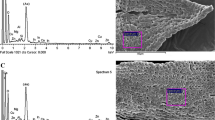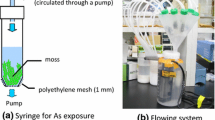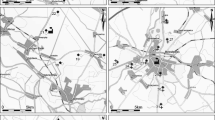Abstract
Scopelophila ligulata is known to be a Fe-hyperaccumulator moss; however, its mechanism of accumulation and the effects of Fe on pigments remain unclear. To clarify the effects, we measured its metal and pigment concentrations. The Fe concentration in S. ligulata was 10–61 times higher than that in normal mosses, confirming that the moss is a Fe-hyperaccumulator. The black samples of S. ligulata had the highest Fe concentration (2.9 wt%) and the second in the order of decreasing Fe concentration (2.2 wt%), which explains their color and indicates that the excess amount of Fe is distributed through the plant body. Moreover, we observed that the concentration of Ca is negatively correlated with the concentrations of pigments and, conversely, that the concentration of K is positively correlated with the concentrations of pigments. This inverse relationship between Ca and K can be explained by the reduced uptake of K in S. ligulata in response to Ca stress, which is supported by the fact that the concentration of Ca is negatively correlated with that of K. These findings provide a better understanding of the relationships between metals and pigments in the Fe-hyperaccumulator moss S. ligulata.



Similar content being viewed by others
References
Aikawa Y, Nagano I, Sakamoto S, Nishiyama M, Matsumoto S (1999) Contents of heavy metal elements in copper mosses: Scopelophila ligulata, Scopelophila cataractae, and Mielichhoferia japonica and their substrates. Soil Sci Plant Nutr 45:835–842
Ali H, Khan E, Sajad MA (2013) Phytoremediation of heavy metals—Concepts and applications. Chemosphere 91:869–881
Ancuceanu R, Dinu M, Hovaneţ MV, Anghel AI, Popescu CV, Negreş S (2015) A survey of plant iron content—a semi-systematic review. Nutrients 7:10320–10351
Bates JW, Farmer AM (1990) An experimental study of calcium acquisition and its effects on the calcifuge moss Pleurozium schreberi. Ann Bot 65:87–96
Chettri MK, Cook CM, Vardaka E, Sawidis T, Lanaras T (1998) The effect of Cu, Zn and Pb on the chlorophyll content of the lichens Cladonia convolute and Cladonia rangiformis. Env Exp Bot 39:1–10
Dietrich WC (1958) Determination of the conversion of chlorophyll to pheophytin. Food Technol 12:428–431
Franco A, Rufo L, Rodríguez N, Amils R, de la Fuente V (2013) Iron absorption, localization, and biomineralization of Cynodon dactylon, a perennial grass from the Río Tinto basin (SW Iberian Peninsula). J Plant Nutr Soil Sci 176:836–842
Gallego SM, Pena LB, Barcia RA, Azpilicueta CE, Iannone MF, Rosales EP, Zawoznik MS, Groppa MD, Benavides MP (2012) Unravelling cadmium toxicity and tolerance in plants: insight into regulatory mechanisms. Env Exp Bot 83:33–46
Hájek M, Plesková Z, Syrovátka V, Peterka T, Laburdová J, Kintrová K, Martin Jiroušek M, Hájek T (2014) Patterns in moss element concentrations in fens across species, habitats, and regions. Per Plant Eco Evo Sys 16:203–218
Harmens H, Norris D, Mills G, and the participants of the moss survey (2013) Heavy metals and nitrogen in mosses: spatial patterns in 2010/2011 and long-term temporal trends in Europe. ICP Vegetation Programme Coordination Centre, Centre for Ecology and Hydrology, Bangor, UK, pp 63
Harmens H, Norris DA, Steinnes E, Kubin E, Piispanen J, Alber R, Aleksiayenak Y, Blum O, Coşkun M, Dam M, De Temmerman L, Fernández JA, Frolova M, Frontasyeva M, González-Miqueo L, Grodzińska K, Jeran Z, Korzekwa S, Krmar M, Kvietkus K, Leblond S, Liiv S, Magnússon SH, Maňkovská B, Pesch R, Rühling Å, Santamaria JM, Schröder W, Spiric Z, Suchara I, Thöni L, Urumov V, Yurukova L, Zechmeister HG (2010) Mosses as biomonitors of atmospheric heavy metal deposition: spatial patterns and temporal trends in Europe. Env Poll 158:3144–3156
Krämer U (2010) Metal hyperaccumulation in plants. Annu Rev Plant Biol 61:517–534
Lichtenthaler HK, Wellburn AR (1983) Determinations of total carotenoids and chlorophylls a and b of leaf extracts in different solvents. Biochem Soc Trans 11:591–592
Maestri E, Marmiroli M, Visioli G, Marmiroli N (2010) Metal tolerance and hyperaccumulation: costs and trade-offs between traits and environment. Env Exp Bot 68:1–13
Nakajima H, Itoh K, Otake H, Fujimoto K (2010) Photoabsorption study of pigments in mosses: scopelophila ligulata has an abnormally high formation rate of pheophytin. Chem Lett 39:284–285
Noguchi A (1988) Illustrated moss flora of Japan, Hattori Botanical Laboratory, Hiroshima, Part 2, p 328
Onianwa PC (2001) Monitoring atmospheric metal pollution: a review of the use of mosses as indicators. Env Monit Assess 71:13–50
Porra RJ, Thompson WA, Kriedemann PE (1989) Determination of accurate extinction coefficients and simultaneous equations for assaying chlorophyll a and b extracted with four different solvents: verification of the concentration of chlorophyll standards by atomic absorption spectroscopy. Biochi Biophy Acta 975:384–394
Rascio N, Navari-Izzo F (2011) Heavy metal hyperaccumulating plants: how and why do they do it? And what makes them so interesting? Plant Sci 180:169–181
Rodríguez N, Menéndez N, Tornero J, Amils R, de La Fuente V (2005) Internal iron biomineralization in Imperata cylindrica, a perennial grass: chemical composition, speciation and plant localization. New Phytol 165:781–789
Shaw AJ (1990) Metal tolerance in bryophytes. In: Shaw AJ (ed) Heavy metal tolerance in plants: evolutionary aspects. CRC Press, Boca Raton, pp 133–152
Sperotto RA, Ricachenevsky FK, Stein RJ, Waldow VA, Fett JP (2010) Iron stress in plants: dealing with deprivation and overload. Plant Stress 4:57–69
Stein RJ, Duarte GL, Spohr MG, Lopes SIG, Fett JP (2009) Distinct physiological responses of two rice cultivars subjected to iron toxicity under field conditions. Ann Appl Biol 154:269–277
Acknowledgments
We thank Mr. Ikuo Asai, Dr. Hiroyuki Akiyama, and Mr. Masaki Michimori for giving us information about the habits of S. ligulata. This study was partly supported by JSPS KAKENHI Grant Nos. 26340045 and 15K12224.
Author information
Authors and Affiliations
Corresponding author
Rights and permissions
About this article
Cite this article
Nakajima, H., Itoh, K. Relationship between metal and pigment concentrations in the Fe-hyperaccumulator moss Scopelophila ligulata . J Plant Res 130, 135–141 (2017). https://doi.org/10.1007/s10265-016-0867-3
Received:
Accepted:
Published:
Issue Date:
DOI: https://doi.org/10.1007/s10265-016-0867-3




